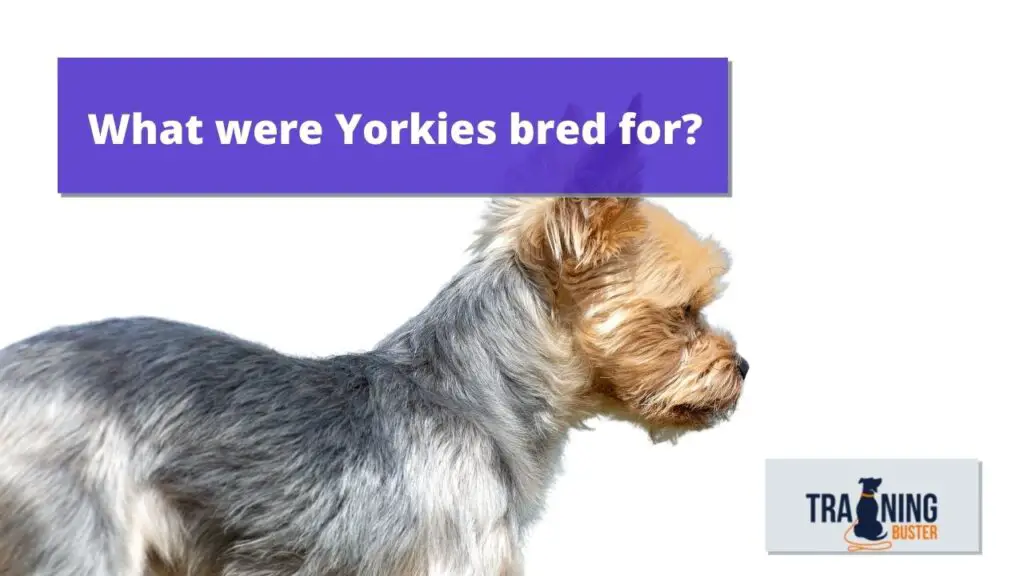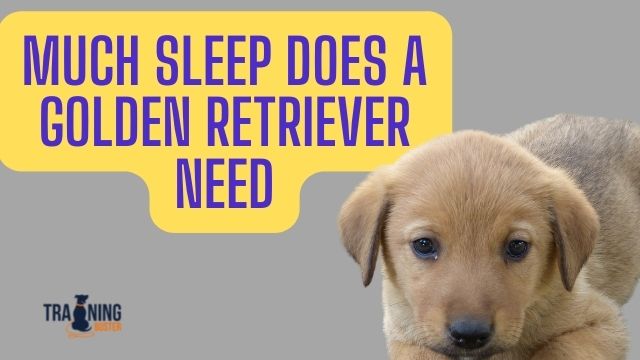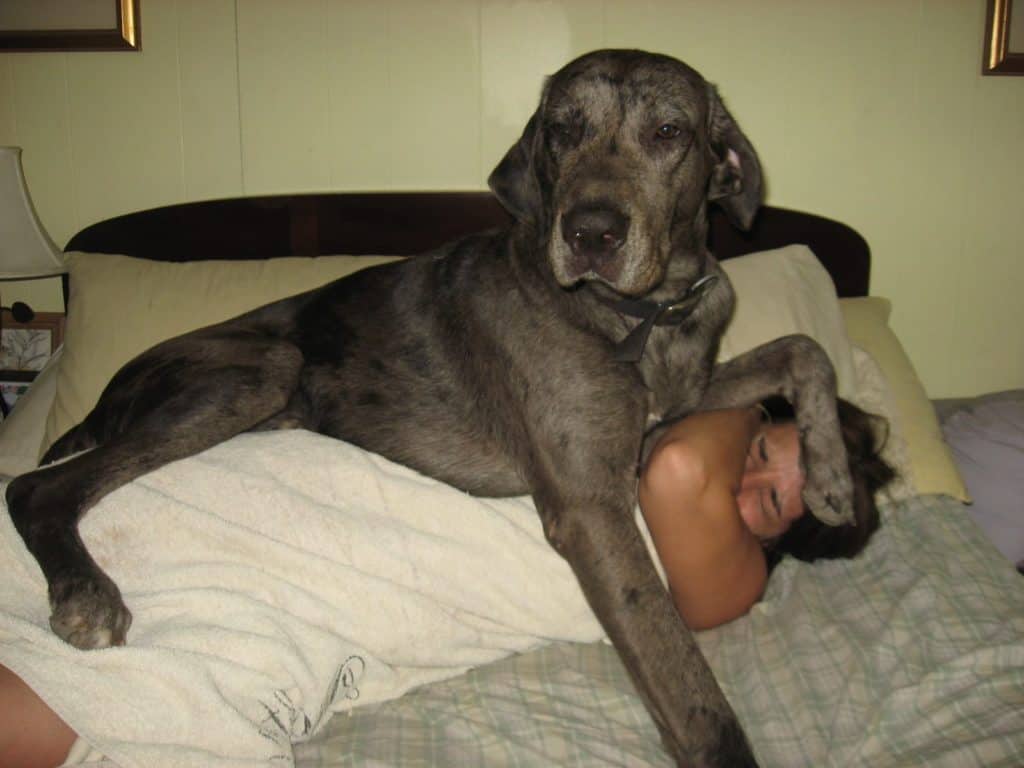A dog whose confidence exceeds its size, the Yorkshire Terrier seems equally at home running around the yard as in a decadent handbag.
With that silky fur and stylish topknot, it wouldn’t be surprising if they came from royalty, right? But what were Yorkies bred for? What jobs did they have, and which dogs were their ancestors? In this post, we answer all these questions and more!

What were Yorkies bred to do?
Ultimately, the Yorkshire Terrier’s main historical use was to catch rats around the factories, textile mills, and coal mines of Scotland and Yorkshire. This is obvious – the Yorkie can still be observed barking at and chasing small animals and toys today. They are alert dogs and will bark to alert you to anyone coming to the door.
However, the Yorkie was also bred as a companion in the past. During the Industrial Revolution, Scottish workers brought a dog called the Paisley or Clydesdale Terrier with them on the trains, to keep them company.
Though a much larger dog, these dogs were crossed with other dogs until they somehow gradually shrank into the handbag and teacup Yorkshire Terrier we know today!
A Brief History of the Yorkshire Terrier
The Yorkshire Terrier originated in England in the mid-19th century. The Yorkshire Terrier was developed from a number of other breeds, including the English Black and Tan Terrier, the Paisley Terrier, the Skye Terrier, and the Clydesdale Terrier.
The terrier was bred to be a small, active, and courageous companion. The breed quickly rose in popularity in England and was first registered with the English Kennel Club in 1886.
By the late 19th century, the Yorkshire Terrier had become a popular city pet among the British upper and middle classes. They were brought to the United States in the late 19th century and were soon recognized by the American Kennel Club in 1885.
The breed quickly gained popularity in the United States and was especially popular among the wealthy. The Yorkshire Terrier is a popular companion dog today. They are intelligent, loyal, and spunky, making them great family pets. The breed is recognized by the American Kennel Club, the Canadian Kennel Club, and the United Kennel Club.
Are Yorkies intelligent?
Yes, the Yorkie is a highly clever and canny pooch! In 1994, a professor of psychology from British Columbia named Stanley Coren carried out a big study on canine intelligence. Stanley came up with 3 distinct groups of intelligence: Instinctive, Adaptive, Working, and Obedience.
Since Stanley Coren wanted to test as many different breeds as he could, Stanley partnered with both the American Kennel Club and the Canadian Kennel Club. The two kennel clubs sent out Stanley Coren’s questionnaires to show judges up and down both countries.
The Canadian and American show ring judges used these questionnaires to evaluate as many purebred dogs as they could. Then, of the breeds that got enough responses, Stanley Coren grouped them into different aptitude groups.
Of the 90 different breeds that ended up being included in the study, the Yorkshire Terrier comes in at 27. This is because the Yorkies surveyed obeyed a new command after 15 to 25 repetitions, on average. That being said, this sample definitely included plenty of Yorkies who were hungry, tired, distracted, stubborn, or who weren’t motivated enough by the treat offered!
Many owners find that their own Yorkshire Terrier responds to commands at home after just 5 or fewer tries, while other Yorkies simply aren’t interested in obedience training or pointless commands, but will excel at other canine sports or will happily learn skills that benefit them! Every dog is an individual, after all.
Another way in which the Yorkshire Terrier is smart is their companionability. Many owners will tell you how their Yorkie simply seems to know what mood they’re in, and how to comfort people and make them happy. This isn’t a surprise when you consider the Yorkshire Terrier’s long past as a companion dog or lapdog.
What did Yorkies evolve from?
As we touched upon earlier, the very first Yorkies were companion dogs that Scottish workers brought to Yorkshire on the trains during the Industrial Revolution. These early Yorkshire Terriers were called Clydesdale Terriers and Paisley Terriers, and would have either lived in the workers’ rooms or earnt their keep at the factories, mines, and mills by keeping rats and other pests at bay.
Later on, these Paisley Terriers and Clydesdale Terriers bred with Skye Terriers, Tan Toy Terriers, the English Black Terrier, the Skye Terrier of Scotland, and maybe even the blue-gray Waterside Terrier to form the tiny, dark, silky-coated, boisterous Yorkshire Terrier that we know and love today.
What is the largest Yorkie?
According to the American Kennel Club’s official breed standards for the Yorkshire Terrier – which have recently been updated – a true Yorkie should be 8 to 9 inches at the shoulder, with a maximum accepted weight of seven pounds, though four to six pounds is the preferred weight range.
However, plenty of purebred Yorkshire Terriers fall outside the AKC’s strict limits. Loads of Yorkies weigh from 8 up to 10 pounds, and this is perfectly normal. These Yorkshire Terriers typically have a large bone structure, and may come from parent dam and sire Yorkies who are on the upper end of the AKC’s staunch guidelines themselves.
Some Yorkies even weigh in at 10 pounds, or even 15! After all, there are so many other ancestors that go into any Yorkshire Terrier’s blood. These dogs are all still perfectly healthy and pedigree. In fact, many larger Yorkies are far more healthy than small ones, especially “mini” or “teacup” ones.
How do you know if a Yorkie is full breed?
The best way to find out whether a Yorkshire Terrier is a pedigree dog is to carry out genetic testing. DNA testing should have been carried out on the Yorkie dam and sire during a vet visit before this Yorkie’s litter was conceived anyway. So, look into this Yorkshire Terrier’s family background before you fork out for that DNA kit.
This may mean getting back in touch with your Yorkie’s breeder for a copy of the
If you do decide to get your Yorkie’s DNA tested, thankfully, home DNA testing kits are simple to use. All they usually entail is just a simple cheek swab to get your Yorkshire Terrier’s DNA. Then, simply ship your Yorkie’s DNA sample off, and you’ll get a breakdown of your pooch’s ancestry within a few weeks or less.
While you’re at it, you can even test for common inherited health conditions that your Terrier may carry. This will help you take better care of your Yorkie and aid you in deciding whether to breed your own Yorkshire Terrier puppies.
Do bear in mind that it’s not the end of the world if your Yorkie isn’t full-bred, however. After all, crossbreed dogs can have better natures and are free from many of the diseases and health conditions that can plague purebred Yorkshire Terriers. A mutt or mongrel may even have a longer life expectancy, and a softer coat, with more interesting markings!
Are all Yorkies born black?
Misleadingly, Dalmatians are born without their quintessential black spots, while Golden Retrievers also have to wait until adulthood to grow into the color that the mere tips of their ears show. So, what about Yorkies? Do they grow into their coats, too?
Well actually, most Yorkies are indeed born with the black and tan markings they will showcase into adulthood, which makes an easy way to guess if they are pedigree. But, some Yorkshire Terriers are instead born completely brown. These Yorkies are called Chocolate Yorkies.
Other Yorkshire Terriers are born with red legs. These Yorkies generally grow up to have longer facial hair than the typical Yorkie Terrier, with a more wiry coat, too.
And then there’s the Parti Yorkie, with the traditional Yorkie face, but a white body! You are lucky to produce such a rare pooch. Parti Yorkies actually helped create the branch-off Biewer Yorkshire Terrier breed, but the piebald Parti Yorkie is still considered purebred.
Even rarer still is the All Black Yorkie. These Yorkshire Terriers may have rough hair that doesn’t grow as long as a standard Yorkie’s, or dull hair that grows even faster.
Other possible Yorkshire Terrier coats include the Golden Yorkie and “Blue Born” Yorkies. Blue Born Yorkies are typically the result of irresponsible breeding, however.


